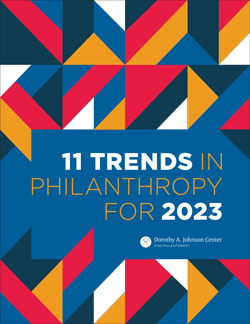ESG Backlash Will Affect the Future of Philanthropy and Impact Investing


 This article was first published in our 11 Trends in Philanthropy for 2023 report. Explore all 11 trends in the report.
This article was first published in our 11 Trends in Philanthropy for 2023 report. Explore all 11 trends in the report.
Want the latest trends, research, and more delivered right to your inbox? Subscribe to the Johnson Center email newsletter.
For several days in September and October of 2022, the comic strip “Dilbert” made fun of something called “ESG” (Quinson). For instance, employees in the comic worried about their company’s low ESG rating and tried to improve it by promoting a person of color (even though that person “identifies as white”) and by adding a non-binary member to their board.
Something showing up in Dilbert is probably a sign that it is trending in our culture wars. Another more reliable indicator is when The Economist does a multi-part, special report on the topic, as it did on ESG in mid-2022.
But what is this ESG thing that Dilbert paints as so absurd, and that The Economist thinks deserves such a deep dive?
The acronym “ESG” stands for “environmental, social, and governance.” Those three terms are general categories covering the range of criteria that can be used to evaluate for-profit corporations, often to determine if an investor should invest in or divest from that company. Environmental criteria might include the company’s total carbon footprint or how it addresses waste or pollution. Social criteria can relate, for instance, to the corporation’s labor practices or its contributions to charity and community engagement. And governance criteria might look at board diversity or salary differentials and transparency (Investopedia, 2022).
ESG is part of a larger shift in the corporate world — one especially driven by younger investors and consumers — toward impact investing and corporate social responsibility (Barman, 2016). ESG specifically has become popular in the past couple decades (PitchBook, 2022), with even the world’s largest asset manager, BlackRock, deciding to prioritize consideration of ESG in its trillions of dollars of investments. BlackRock’s decision has stirred quite the controversy, however (Goldstein & Farrell, 2022), which shows there is a robust debate over ESG’s definition, measurement, and proper use (Foroughi, 2022). Two of the three “most popular” articles in Stanford Social Innovation Review in 2022 had “ESG” in the title.
“To help navigate the difficult waters ahead … we need better, more long-term data on the performance of ESG investments.”
ESG is an increasingly relevant issue in philanthropy because any philanthropic organization that has an endowment must make choices about how that endowment is invested — or at least work closely with the experts who make those choices. This applies to endowed private foundations of course, but also to public charities with endowments — Harvard’s exceeds $50 billion (Ma & Simauchi, 2021) — and public charities that sponsor donor-advised funds (DAF).
It has become gradually more common for endowed private foundations to invest at least a portion of their endowments in ways that conform to their philanthropic missions (Council on Foundations-Commonfund, 2021), something that was traditionally called “mission-related investing.” In doing so, they embody what has become an old saw in the field: to try to “do good with the 95% not just the 5%.” Foundation investment managers are screening out tobacco or fossil-fuel companies, for example (McClimon, 2022). Recently, Lukas Walton, grandson of the Walmart founder, committed 90% of a $1 billion family foundation endowment to ESG investments (Cao, 2022). DAF sponsors like Fidelity Charitable give donors the option of investing their endowed funds in ESG-aligned ways (2022).
A handbook produced by Rockefeller Philanthropy Advisors puts it this way: “Impact investing is a powerful force that is reshaping how philanthropy defines its operating models, … Without impact investing, the kind of systems change we need to solve deeply persistent challenges and inequities will continue to elude us” (Godeke & Briaud, 2020, p. 10).
ESG has always been somewhat controversial. Early critics were often from the political Left, arguing that companies were engaging in “greenwashing” — providing misleading or incomplete (or sometimes false) information about their sustainability practices — in order to get higher ESG scores and to attract eco-conscious consumers and investors (The Economist, 2021). While this critique continues (Taparia, 2022), most of the recent backlash has come from the political Right — and it has become much more vociferous.
A Wall Street Journal op-ed by former Vice President Mike Pence, published in May 2022, called on fellow Republicans to fight against ESG and the “woke capitalism” it represents. Later that summer, Florida Gov. Ron DeSantis pushed through legislation forbidding ESG considerations when investing any state funds, such as pension funds. Other states such as Texas and Louisiana have made similar moves, including pulling funds from BlackRock explicitly because of ESG (Guynn, 2022). And following the recent elections, the Republican majority in the U.S. House of Representatives is promising legislative action to combat ESG (Meyers, 2022).
While there are several types of criticisms leveled against ESG in this current backlash, the most common are:
ESG perpetuates “wokeism” and “cancel culture.” Critics argue that ESG is merely a way to impose “woke” progressive ideals and restrictions outside of normal political channels and that it unfairly discriminates against certain companies and encourages people to “cancel” them as “enemies” (Green & Kishan, 2022).
ESG investments underperform and prioritize politics over free markets. While both sides cite different data on this point, critics claim that ESG-approved investments financially underperform, thus harming investors, consumers, and others (Keeley, 2022). More generally they argue that ESG interferes with free markets, and forces companies to try to please activists rather than shareholders.
This rapidly intensifying backlash against ESG considerations will affect philanthropy more and more as impact investing by philanthropic institutions continues to grow — as most expect it will — and as younger donor-investors continue to use both their giving and their investing as integrated tools for social change. This will likely be another way that philanthropy gets increasingly drawn into the nation’s “culture wars” (Behrens, 2022). In fact, it’s already happening: the Philanthropy Roundtable’s October 2022 Annual Meeting featured a keynote panel discussion on “ESG: An Insidious Threat to Free Society and Philanthropy” (2023, para. 2).
To help navigate the difficult waters ahead, it is clear we need better, more long-term data on the performance of ESG investments. For nonprofit and foundation endowments, this data is vital because lower returns theoretically mean less money available for grantmaking or nonprofit programs, even if the investments are also advancing the mission. Improving our ESG metrics and rating systems will also certainly help philanthropic institutions and socially conscious investors. Some are calling for ESG ratings to consider more highly a company’s philanthropic work, for instance (Joss, 2021). Finally, some proponents are trying to turn down the heat of the debate by developing clearer and more widely shared definitions and terms, or even using a different label besides “ESG” (Horoszowski, 2022; Kishan & Schwartzkopff, 2022).
The most optimistic views see philanthropy playing an even larger role in the future of ESG. Debra Schwartz from the John D. and Catherine T. MacArthur Foundation, for example, envisions more philanthropic funding to support the development of better measurements and additional network connections or learning opportunities for impact investment professionals, as well as even more intentional investments by philanthropic institutions (2022).
However it eventually affects philanthropy, the debate about ESG doesn’t seem to be going away anytime soon.
Barman, E. (2016). Caring capitalism: The meaning and measure of social value. University Press.
Behrens, T. (2022, January 18). Philanthropy is increasingly embroiled in the culture wars. 11 trends in philanthropy for 2022. Dorothy A. Johnson Center for Philanthropy. https://johnsoncenter.org/blog/philanthropy-is-increasingly-embroiled-in-the-culture-wars/
Cao, S. (2022, September 19). Walmart heir Lukas Walton commits 90% of $1 billion family foundation to impact investing. Observer. https://observer.com/2022/09/walmart-hier-lukas-walton-commit-foundation-esg-investing/
Council on Foundations-Commonfund. (2021). Study of investment of endowments for private and community foundations. https://www.commonfund.org/research-center/press-releases/council-on-foundations-commonfund-study-of-foundations-released
The Economist. (2021, May 22). Sustainable finance is rife with greenwash. Time for more disclosure. https://www.economist.com/leaders/2021/05/22/sustainable-finance-is-rife-with-greenwash-time-for-more-disclosure
The Economist. (2022, July 23). A broken idea ESG investing. https://www.economist.com/special-report/2022-07-23
Fidelity Charitable. (2022, October 31). Sustainable and impact investing. https://www.fidelitycharitable.org/giving-account/investment-options/impact-investing-pool.html
Foroughi, J. (2022, November 10). ESG is not impact investing and impact investing is not ESG. Stanford Social Innovation Review. https://doi.org/10.48558/5K24-4Q54
Godeke, S., & Briaud, P. (2020, October 1). Impact investing handbook: An implementation guide for practitioners. https://www.rockpa.org/wp-content/uploads/2020/10/RPA-Impact-Investing-Handbook-1.pdf
Goldstein, M., & Farrell, M. (2022, December 23). BlackRock’s pitch for socially conscious investing antagonizes all sides. The New York Times. https://www.nytimes.com/2022/12/23/business/blackrock-esg-investing.html
Green, J., & Kishan, S. (2022, May 20). America’s political right has a new enemy no. 1: ESG investors. Bloomberg. https://www.bloomberg.com/news/articles/2022-05-20/why-esg-investing-is-under-republican-attack
Guynn, J. (2022, December 1). Florida, DeSantis yank billions in investments from ‘woke’ BlackRock over ESG investing. USA Today. https://www.usatoday.com/story/money/2022/12/01/florida-desantis-blackrock-esg-woke/10812382002/
Horoszowski, M. (2022, October 11). ESG needs a shared language. Stanford Social Innovation Review. https://doi.org/10.48558/Z1G1-F207
Investopedia. (2022, September 27). What is environmental, social, and governance (ESG) investing? https://www.investopedia.com/terms/e/environmental-social-and-governance-esg-criteria.asp
Joss, K. (2021, April 14). Let’s measure what’s impactful instead of what’s easy in ESG. https://www.globalgiving.org/learn/philanthropy-and-esg
Keeley, T. (2022, October 17). Why ESG funds fail, and how they could succeed. The Wall Street Journal. https://www.wsj.com/articles/why-esg-funds-fail-and-how-they-could-succeed-impact-investing-financial-value-divest-dei-emissions-brown-green-11666038061
Kishan, S., & Schwartzkopff, F. (2022, August 17). ‘Hating ESG’: Advocates are looking to replace the label. FA Financial Advisor. https://www.fa-mag.com/news/-hating-esg—advocates-are-looking-to-replace-the-label-69262.html
Ma, V. L., & Simauchi, K. A. (2021, October 15). Harvard’s endowment soars to $53.2 billion, reports 33.6% returns. The Harvard Crimson. https://www.thecrimson.com/article/2021/10/15/endowment-returns-soar-2021/
McClimon, T. J. (2022, March 7). Foundations begin to embrace ESG. Forbes. https://www.forbes.com/sites/timothyjmcclimon/2022/03/07/foundations-begin-to-embrace-esg/?sh=3ad6ff036440
Meyers, E. (2022, December 8). Emboldened House Republicans to bring ESG scrutiny, experts say. Roll Call. https://rollcall.com/2022/12/08/emboldened-house-republicans-to-bring-esg-scrutiny-experts-say/
Pence, M. (2022, May 26). Republicans can stop ESG political bias. The Wall Street Journal. https://www.wsj.com/articles/only-republicans-can-stop-the-esg-madness-woke-musk-consumer-demand-free-speech-corporate-america-11653574189
Philanthropy Roundtable. (2023, January 4). Why the ESG movement poses a threat to free society. https://www.philanthropyroundtable.org/why-the-esg-movement-poses-a-threat-to-free-society/
PitchBook. (2022, October 4). Sustainable investment survey. https://pitchbook.com/news/reports/2022-sustainable-investment-survey
Quinson, T. (2022, September 21). ‘Dilbert’ becomes the voice of ESG opposition. Bloomberg Green ESG. https://www.bloomberg.com/news/articles/2022-09-21/-dilbert-becomes-the-voice-of-the-esg-opponents-green-insight
Stanford Social Innovation Review. (2022). The 10 most popular SSIR articles of 2022. https://doi.org/10.48558/404W-YW16
Schwartz, D. (2022, October). Why impact investing needs philanthropy and catalytic capital. GreenMoney. https://greenmoney.com/why-impact-investing-needs-philanthropy-and-catalytic-capital/
Taparia, H. (2021). The world may be better off without ESG investing. Stanford Social Innovation Review. https://doi.org/10.48558/PC0C-TV52
Taparia, H. (2022, September 29). One of the hottest trends in the world of investing is a sham. The New York Times. https://www.nytimes.com/2022/09/29/opinion/esg-investing-responsibility.html